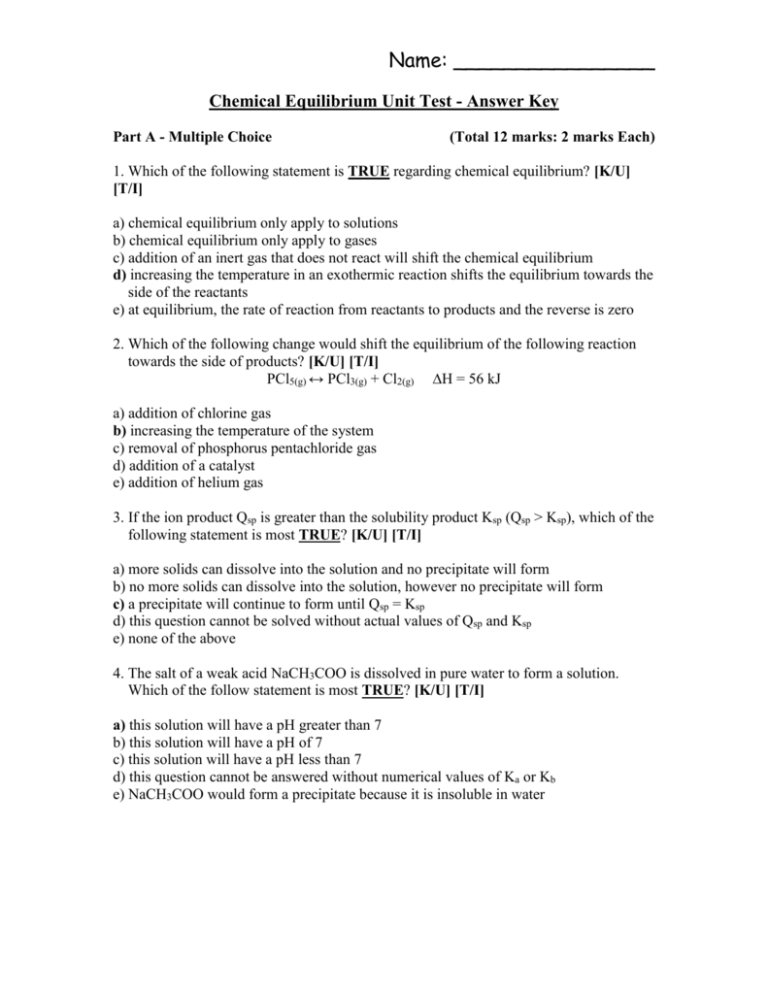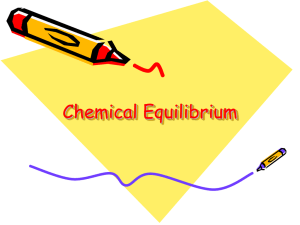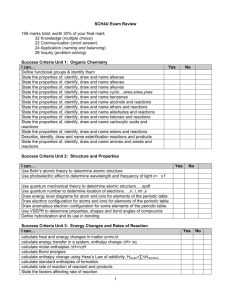Chemical Equilibrium Unit Test - Chemicalsystemsandequilibrium
advertisement

Name: ________________ Chemical Equilibrium Unit Test - Answer Key Part A - Multiple Choice (Total 12 marks: 2 marks Each) 1. Which of the following statement is TRUE regarding chemical equilibrium? [K/U] [T/I] a) chemical equilibrium only apply to solutions b) chemical equilibrium only apply to gases c) addition of an inert gas that does not react will shift the chemical equilibrium d) increasing the temperature in an exothermic reaction shifts the equilibrium towards the side of the reactants e) at equilibrium, the rate of reaction from reactants to products and the reverse is zero 2. Which of the following change would shift the equilibrium of the following reaction towards the side of products? [K/U] [T/I] PCl5(g) ↔ PCl3(g) + Cl2(g) ∆H = 56 kJ a) addition of chlorine gas b) increasing the temperature of the system c) removal of phosphorus pentachloride gas d) addition of a catalyst e) addition of helium gas 3. If the ion product Qsp is greater than the solubility product Ksp (Qsp > Ksp), which of the following statement is most TRUE? [K/U] [T/I] a) more solids can dissolve into the solution and no precipitate will form b) no more solids can dissolve into the solution, however no precipitate will form c) a precipitate will continue to form until Qsp = Ksp d) this question cannot be solved without actual values of Qsp and Ksp e) none of the above 4. The salt of a weak acid NaCH3COO is dissolved in pure water to form a solution. Which of the follow statement is most TRUE? [K/U] [T/I] a) this solution will have a pH greater than 7 b) this solution will have a pH of 7 c) this solution will have a pH less than 7 d) this question cannot be answered without numerical values of Ka or Kb e) NaCH3COO would form a precipitate because it is insoluble in water Name: ________________ 5. Acetic acid CH3COOH dissolved into water to form a solution. Which of the following equilibrium expression best describe the acid dissociation constant Ka for acetic acid in water? [K/U] a) [H3O+][CH3COOH] / [CH3COO-] b) [H3O+][CH3COOH] / [CH3COO-][H2O] c) [CH3COO-][H2O] / [H3O+][CH3COOH] d) [H3O+][CH3COO-] / [CH3COOH] e) [H3O+][CH3COO-] / [CH3COOH][H2O] 6. In the following chemical equation of the ionization of H3PO4(aq) in water, what best describes H2PO4-(aq)? [K/U] [T/I] H3PO4(aq) + H2O(l) ↔ H2PO4-(aq) + H3O+(aq) a) acid b) base c) conjugate acid d) conjugate base e) indicator Part B - Fill in the Blank (Total 8 marks: 1 mark each blank) 7. In a reversible chemical reaction, addition of an ___inert gas___ [T/I] that does not react with the system or the additional of a ____catalyst______ [T/I] does not change the chemical equilibrium of the system. 8. Equilibrium can only be reached in a _______closed _____ [T/I] system. This system does not allow the input or escape of any component of the equilibrium system, including energy. For this reason, a system can be at equilibrium only if it is at constant ___temperature___. [T/I] 9. ___Le Châtelier's principle__ states that a dynamic equilibrium tends to respond so as to relieve the effect of any change in the conditions that affect the equilibrium. [K/U] 10. In a given chemical equilibrium where the equilibrium constant Keq > 1, it can be said that the reaction favours the formation of __products___. [T/I] 11. NH3 + ____base_____ [K/U] Possible choices: Le Châtelier's principle Inert gas Temperature Catalyst Pressure H2O acid ↔ NH4+ conjugate acid Molar solubility Closed Conjugate base Products Concentration + OHconjugate base [K/U] Base Open Volume Reactants Acid Name: ________________ Part C - Short Answer (Total 33 marks) 12. You prepared 0.10 mol/L solution propanoic acid CH3CH2COOH (a weak acid) and using the pH meter found that it has a pH of 2.96. What is the acid dissociation constant Ka for propanoic acid? What percent of its molecules are ionized in the solution? (6 marks) [ ] (M) CH3CH2COOH(aq) + H2O(l) ↔ CH3CH2COO-(aq) + H3O+(aq) Initial 0.10 0 0 Change -x +x +x Equilibrium 0.10 - x +x +x (2 marks) - 1 for balanced equation [K/U] and 1 for correct ICE table [K/U] Ka = [CH3CH2COO-][H3O+] / [CH3CH2COOH] = x2/(0.10 - x) (1 mark) [T/I] [H3O+] = 10-2.96 = 1.1 x 10-3M =x (1 mark) [T/I] Ka = (1.1 x 10-3)2 / 0.10 - (1.1 x 10-3) = 1.2 x 10-5 (1 mark) [T/I] % ionization = 1.1 x 10-3M / 0.10M = 1.1% (1 mark) [T/I] x 100% Name: ________________ 13. In acid-base titration, we often use an indicator to help visualize where the end-point of our reaction is. Indicators are often weak, monoprotic organic acids that changes colour over a certain range of pH. Thymol blue is a diprotic acid that can also be used as an indicator. Explain what will be the case of using thymol blue as an indicator for an acid-base titration. Be sure to talk about what happens as pH increases or decreases in solution, using diagrams where appropriate. (4 marks) Since it is a diprotic acid, we expect thymol blue to have 2 different pH ranges at which a colour change will occur. (1 mark) [A] H2In(aq) + H2O(l) ↔ H3O+(aq) + HIn-(aq) At low pH, we would expect the indicator to be in its fully protonated form H2In with a given colour (1 mark) [A] and as we lower the pH, it will get deprotonated once into HIn- and that will result in a colour change (1 mark). [A] HIn-(aq) + H2O(l) ↔ H3O+(aq) + In2-(aq) When we lower the pH even more, HIn- will be further deprotonated into In2- and as a result change into another colour. (1 mark) [A] Name: ________________ 14. Lead (II) iodide PbI2 is a golden yellow colour that was used in the nineteenth century for artwork. At 25˚C, the Ksp of PbI2 is 9.8 x 10-9. What is the molar solubility of PbI2 in water at 25˚C? (5 marks) PbI2(s) ↔ Pb2+(aq) + 2I-(aq) (1 mark) [K/U] Ksp = [Pb2+][I-]2 (1 mark) [T/I] [ ] (M) Initial Change Equilibrium (1 mark) [K/U] PbI2(s) - ↔ Pb2+(aq) 0 +x x + 2I-(aq) 0 + 2x 2x Ksp = [Pb2+][I-]2 = x (2x)2 = 4x3 = 9.8 x 10-9 (1 mark) [T/I] x = 3√(9.8 x 10-9 / 4) = 1.3 x 10-3M (1 mark) [T/I] 15. List 3 ways in which we can use chemical equilibrium to our advantage. For each of these 3, briefly describe how they work. (6 marks) i) Industries can use chemical equilibrium to increase yield of a chemical reaction. (1 mark) [A] By constantly removing the desired product produced or by constantly adding heat to an endothermic reaction, industries can shift the chemical equilibrium to favour formation of desired products. (1 mark) [C] ii) Removal of toxic heavy metals in the body through the use of chelators involve chemical equilibrium. (1 mark) [A] Chelators bind to heavy metal that may have accumulated in our body through an equilibrium shift process, as chelators bind to free heavy metal ions in our body, more heavy metal trapped in our tissues and organs become freed through an equilibrium shift, which allows for further binding to chelators. (1 mark) [C] iii) Drug tablets for oral ingestion can be buffered. (1 mark) [A] These tablets are buffered because our stomach is acidic, such that weak acid drugs will not be ionized in our stomach. Addition of a buffer to the drug tablet can alter the equilibrium such that more drug molecules can become unionized in our stomach for absorption to the stomach lining if deemed necessary for treatment. (1 mark) [C] Name: ________________ 16. Explain the role of a buffer in acid-base equilibrium. Consider the following acidbase equilibrium to help formulate your answer, using diagrams where appropriate. CH3COO-(aq) + H3O+(aq) ↔ CH3COOH(aq) + H2O(l) (4 marks) Using the above example, acetate ions act as a buffer in this system. (1 mark) [C] As you decrease the pH, more H3O+ are formed shifts the equilibrium towards the right side. This causes the pH to become higher than it would have been if no acetate ions were in the system. (1 mark) [C] The opposite is true for this example. CH3COOH(aq) + OH-(aq) ↔ CH3COO-(aq) + H2O(aq) (1 mark) [C] As you increase the pH in this same system, the acetic acid act as a buffer to resist pH change by reacting with hydroxide ions to shift the equilibrium towards the right to form water and acetate ions. (1 mark) [C] Name: ________________ 17. Sodium acetate CH3COONa is the sodium salt of acetic acid. It is widely used in industries to neutralize strong acids because it is cheap and easy to produce. Find the value of the base dissociation constant Kb of acetate ion given Ka for acetic acid is 1.81x 10-5. Then calculate the pH of a solution that contains 12.5g of sodium acetate dissolved in 1L of water. (8 marks) Kb = Kw/Ka (1 mark) [K/U] = 1.0 x 10-14/ 1.8 x 10-5 = 5.6 x 10-10 (1 mark) [T/I] Molar mass of CH3COONa = 82 g/mol [CH3COONa] = 12.5g/ (82 g/mol x 1L) = 0.152M (1 mark) [T/I] ~ [CH3COO-] assume 100% ionization in solution [ ] (M) Initial Change Equilibrium (1 mark) [K/U] CH3COO-(aq) 0.152 -x 0.152 - x + H2O(l) ↔ - CH3COOH(aq) 0 +x x + OH-(aq) 0 +x x Kb = [CH3COOH][OH-] / [CH3COO-] = x2/ (0.152 - x) (1 mark) [T/I] Since [CH3COO-] / Kb = 0.152 / (5.6 x 10-10) >> 500, we will assume that 0.152 - x is approximate 0.152. Kb = x2/ 0.152 5.6 x 10-10 = x2/ 0.152 x = 9.2 x 10-6M ; omit negative root, it does not make sense [OH-] = 9.2 x 10-6M (1 mark) [T/I] pOH = -log[OH-] = 5.04 (1 mark) [T/I] pH = 14 - pOH = 14 - 5.04 = 8.96 (1 mark) [T/I]







